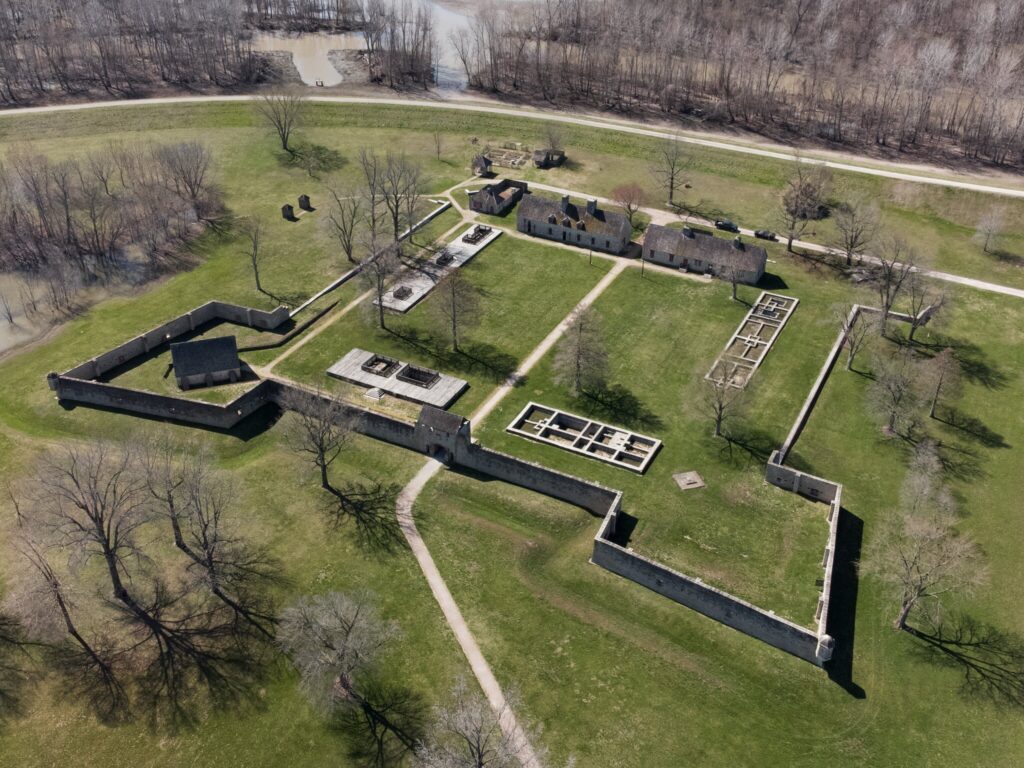
About a year ago I got into drone photography with my first drone, a tiny DJI Mini 2. While not the fanciest of drones it does a pretty good job for the price point. Easy to control and decent 4k video.1
One of the downsides is that the onboard software will stitch a 360 degree panorama for you, but only at a lower resolution. The Mini 2 does have a nifty feature to take all 26 photos needed for a complete 360 view, in the DNG format, but it can’t stitch it together for you. So what is a person to do? Enter open-source tools!
I’ve done this a few times and each time I have to remember all the steps. Time to write it all down for myself and if I’m lucky to help others too. 2
Take your photos
First you need to take the photos!
Position your drone somewhere near the object or location you want to take a panorama of. Do not place your drone directly above the point of interest! You want to position the drone away from direct center. It helps make sure your POI gets the best coverage of direct photos. Make sure the drone is between the sun and the point of interest. Don’t have both your POI and the sun in the same direction. You’ll end up with blown out sun flares. I did not do this perfectly with my image above of the Fort, but you can see that the sun is off to the left from where my drone was. You have to learn the rules before you can break them.
Once positioned, switch the mode to Pano and select Sphere.
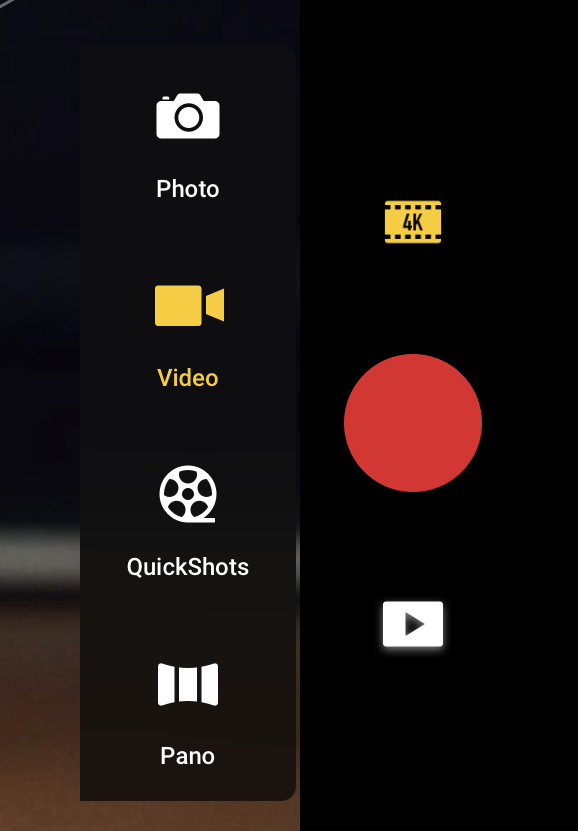
Then make sure your format is set to jpeg + RAW3
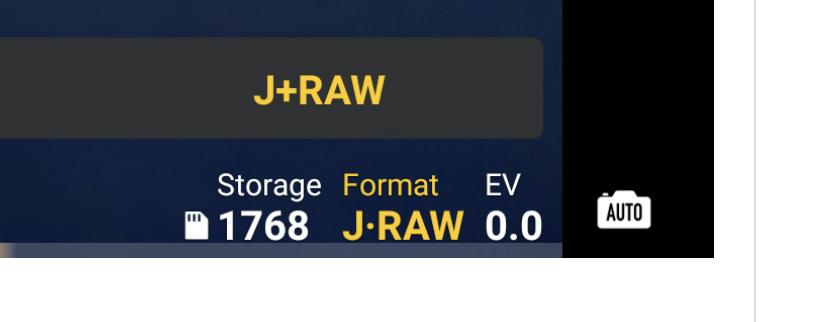
Once ready, hit the red record button and let the drone take the photos. It will hover in place and rotate both the gimbal and drone to get as much coverage as possible.
Now you have your drone up in the sky, positioned nicely and you’ve taken some photos. Time to return to the computer. You have a folder of DNGs that are waiting to be stitched together. Enter Hugin.
Hugin
Hugin is an open-source panorama photo stitcher.4 It’s a powerful tool with many knobs and dials. I’m going to focus on the settings that I think are important, but please do read up on all the software can do. I’m doing this all on a Mac, but the interface and steps are generally the same.
Speaking of Macs, the most recent version of Hugin for Mac was last updated in February of 2019. If you’re using a Mac with a Retina (HiDPI screen) display you’ll want to grab a beta release that fixes an issue with Macs with this screen. It’s unfortunately still out-of-date compared to the Linux and Windows releases.
As noted on Hugin’s download section, “On Mac OS 10.15 Catalina and later you will need to manually grant Hugin “Full Disk Access” in the Privacy tab of the OS X System Preferences, Security & Privacy.” Since we’re using an out-of-date and not well supported version of Hugin on the Mac, you’ll want to right-click on the Hugin.app and select Open or else you’ll get a scary warning about it not being trusted (you can trust it). Do the same for PTBatcherGUI.app. You’ll also want to make sure Hugin has Full Disk Access as noted above. Check these settings in System Preferences>Security & Privacy.
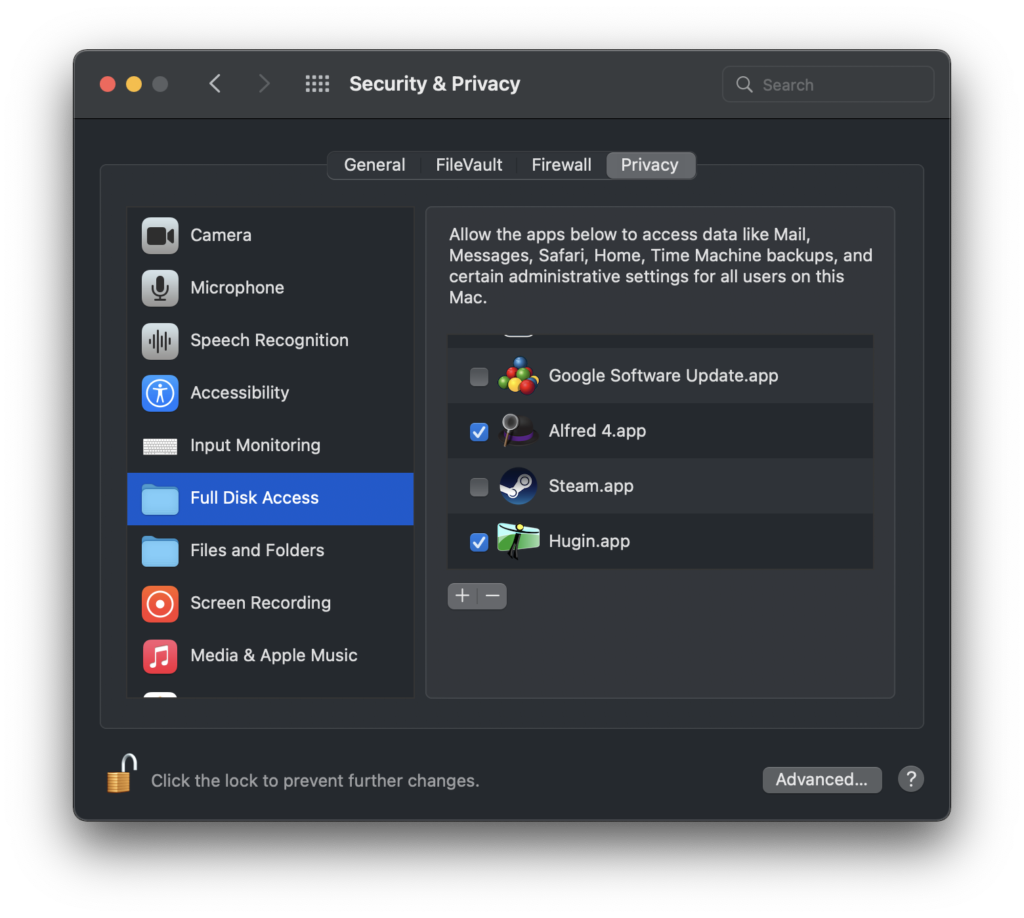
Ok, you’ve download Hugin and installed it. The second step done.
DNGs to PNGs
If you’re using the settings above on your Mini 2, you’ll end up with image files in the DNG and JPG formats. We want to use the DNGs as they have more data and less compression. You’ll need to convert them to another format to use with Hugin. You can do this a myriad of ways. If you’re using a modern Mac, a Shortcut workflow to select files and convert to PNG works just fine.
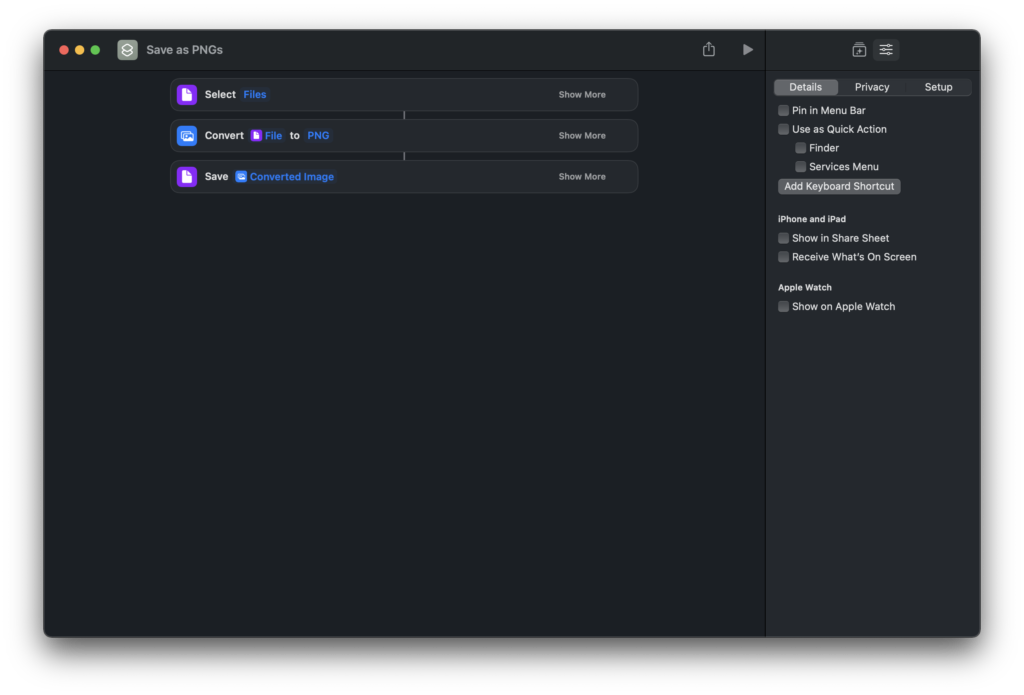
Loading images into Hugin
Open Hugin and select Load images… from the main window. You’ll want to Shift+click to select all the PNGs we created earlier.
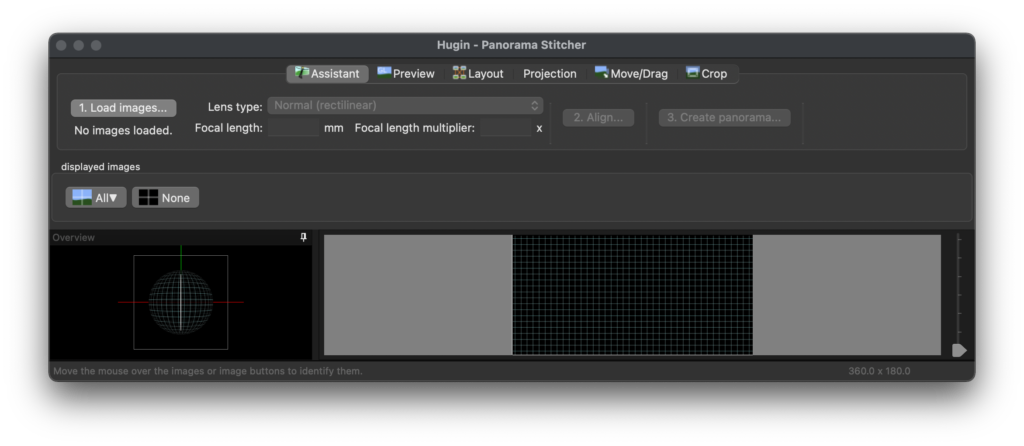
Depending on how you converted the DNGs to PNGS you may be missing the metadata for your lens type. You’ll then see a window asking about the Camera and Lens data. Here’s the settings to use.5

Lens type: Normal (rectilinear)
Focal length: 4.49 mm
Focal length multiplier 5.345 x
Select Ok. You should see your images in a jumbled mess in the Overview window in Hugin. That’s not right! Click 2. Align… in the main Hugin window.
A new window will pop up and the magic starts. Hugin will analyze all the images and look for points where the images overlap. This might take a few minutes depending on how speedy your computer is. Let it do its thing.
Fine tuning
Once complete, you’ll see something that looks a little more put together. Maybe like a giant ant hill, but at least the sky and ground is consistently attached.
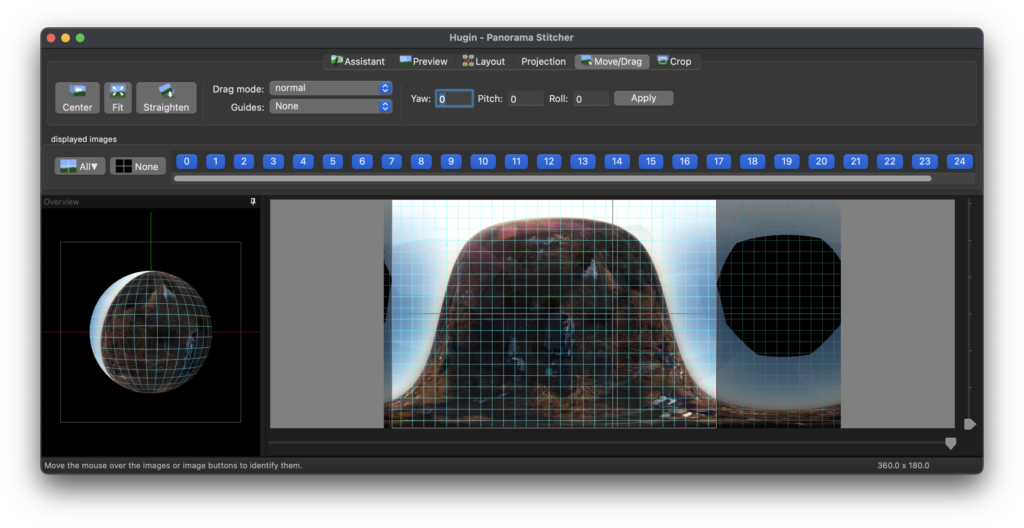
Head over to the Move/Drag option in the main Hugin window. Click Straighten. Hey look, a panorama with a straight horizon and all! Is it upside down? No problem. Roll the image by 180 and click Apply. Click Straighten again for good measure.
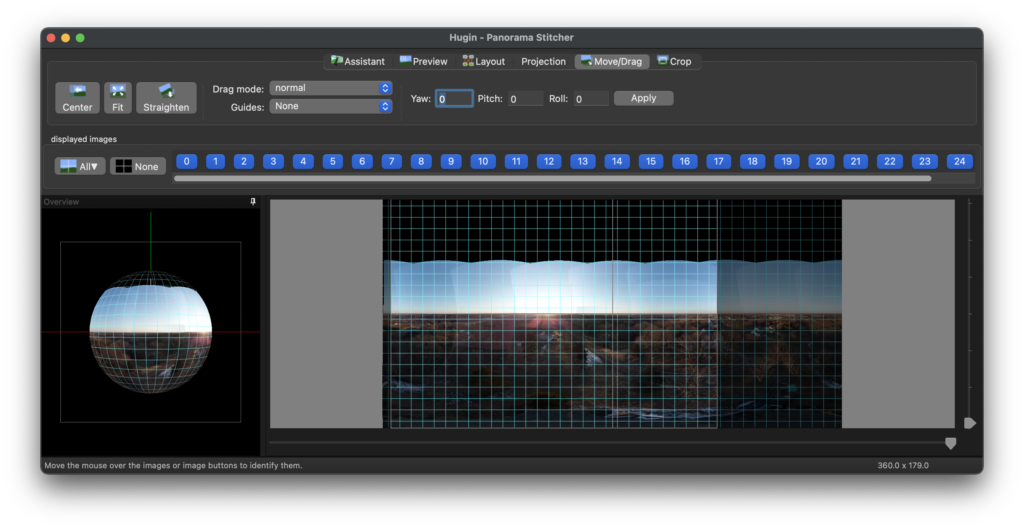
Export
Time to tell Hugin to make you a single image. Save your project. Go to File>Save in the menu bar or use the handy command+S to save your project. Head back to the Main Assistant window and select Interface>Expert from the menu bar. “What?”, you might be saying. “I’m not an expert!” Don’t worry. We’re going to use this interface to make a few small tweaks.
Once the Advanced menu option is selected you’ll see a new window. Select the Stitcher tab.

Form here, make sure the projection is set to Equirectangular. Field of View should be 360 x 180. For Canvas Size click “Calculate optimal size”. The Width, and the Height should be at a ratio of 2:1. So 18648 x 9324, 9482 x 4715, 4096 x 2048, etc. Hugin likes to be helpful and crop out the top of the image where there is no sky (Dones can’t look up!). If you see the Top setting under Crop set to anything other than zero, change it to zero.
I find it helpful to export two versions. One exposure corrected with low dynamic range and the other fused from any arrangement. So I suggest checking the “Exposure fused from any arrangement” option as well.
Hit Stitch! And you’ll be asked to specify the prefix for your images. You can leave this as the default or change it to your liking. Then away it goes! This will take some time.
Once complete you’ll have two big TIFF files. By default this will be in the same folder where you saved your project file. One will just have the prefix, the other _blended_fused.
Most times the blended version is the best. These are big files, about 700 MB. If you don’t need/want such a large file, you can always adjust the canvas size in the Stitcher. Just keep the ratio at 2:1.
Take a look at your images. Pick which one you prefer.

Pretty good, eh? All except for the giant void where the sky should be. Time to fix that.
Skyfill
More open-source software! This time we’re going to use a utility called Skyfill to fill in the sky. We can close Hugin for now. Go download Skyfill. There are Linux, Windows, and MacOS (Darwin) versions. Open the zip and inside you’ll see a file called skyfill.
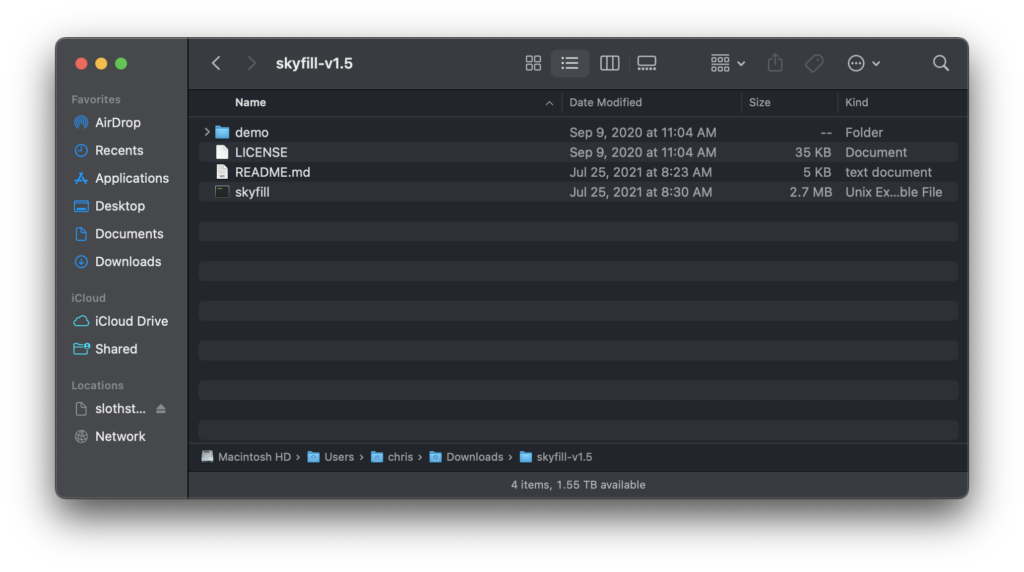
This is a command-line utility, so no point-and-click for this bit. Right-click/control-click on the skyfill file to open it. A Terminal window will open and a bunch of text will appear. You just ran skyfill but with no settings so it will say [Process completed] without actually doing anything. You can close that window. Why did we do all of that? In doing that we did give the program permission to run from the Terminal.
Time to use the Terminal! Open the Terminal app on your Mac by going to Applications>Utilities>Terminal.app. Drag and drop the skyfill file into the Terminal window that appears. You should see something like this.
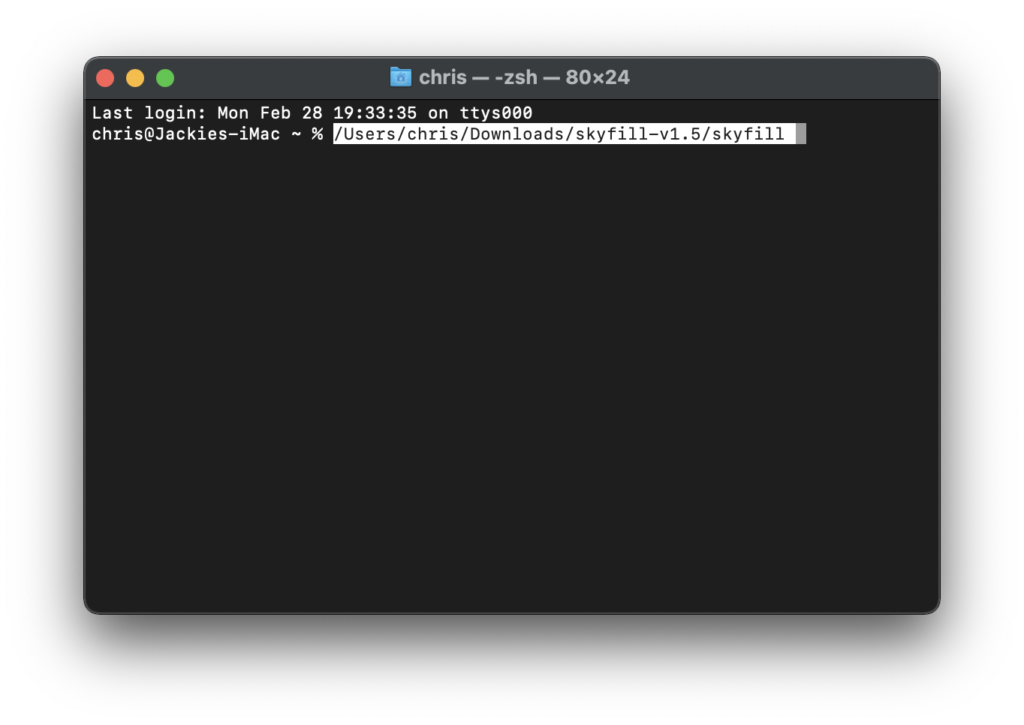
If you hit return, skyfill will run, but again not do anything. It doesn’t know where the image from Hugin is or what settings you want to use. With the command to run Skyfill still in the Terminal, drag your image to the Terminal window. You should see something like this.

Hit return and skyfill should do its work to fill the sky. The result is a giant TIFF file in the same folder as your source image with the sky filled in. It will have “-filled” appended to the file name.6

So here’s an 360 image where I break the rules when we first began. I have my subject (a house) right below the drone and the sun blaring at the camera. A terrible photo but illustrative of why you shouldn’t frame your photo this way! 🙂
Cleanup
From here you might need to touch things up. Maybe remove an errant bird or adjust the colors. Load the TIFF image into your favorite image editor of choice and go to town. I’m skipping details here because personal preferences differ when it comes to editing software and depending on where and when your image was taken you may have more or less editing to do. Personally I used Pixelmator Pro and do a light pass in editing.
Share
Once you have your image all cleaned up you’ll want to share it with folks. I have a few suggestions and there are other ways to do this.
Flickr
You an upload your image to Flickr as a PNG and the site can display your image in a 360 view. You’ll need to add the equirectangular tag to your image and refresh the page. Here’s an example. You can upload images at large resolutions, but the built-in viewer will downsample them. There is no ability to zoom in on an image.
kuula.co
Kuuala has a nice interface where you can customize the focal point and default view. It accepts photos up to 16384 x 8192 in PNG and allows for viewers to zoom the image.
Google Streetview
If you can get your final image on to a mobile device, you can download the Google Streetview app and upload your photo to Google Maps. Here’s an example of one I created and uploaded.
There are some downsides. Google now “owns” your image and you have very little chance to interact with anyone viewing your images. However, given the reach of Google, many more people can see and enjoy your photos.
Conclusion
This isn’t the perfect tutorial and there may be other tools to help with some of the steps. In my desire to use open-source when possible, this is what worked best for me. If you have a tip or question, please leave a comment. Now go have fun with your sky camera!
Footnotes
- I crashed mine on the second time out flying. Which if I understand correctly is the natural way to become a seasoned drone pilot.
- If this introduction was any longer you’d think I was sharing a family recipe on the internet.
- DNG is the format DJI uses for RAW images
- Named after the Norse ravens?
- If you use the jpgs created from the drone directly, they will have the lens metadata intact, but you will sacrifice image quality.
- There are options to specify the output settings for skyfill in the 1.6 version which is not released as of yet. For example, you can append “-out png” without the quotes to export the file as a PNG, saving you a step.